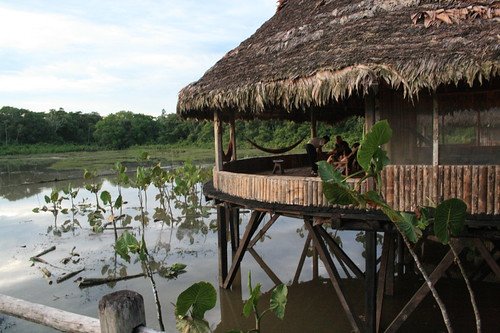Kapawi Ecolodge - Jungle Treks
Kapawi Ecolodge - Jungle Treks, Jungle Treks at Kapawi Ecolodge - Days 5/8 - Tuesday 27th/ Friday 30th March I''ve decided to accumulate the Treks into one Blog, and then perhaps one for the river trips. They certainly work you hard at Kapawi ecolodge. There are many options on offer, and the daily activities can readily be suited to your particular needs or interests. Our daily routine settled into an early morning (06:30 hrs) birdwatch from the motorised canoe & back for breakfast. This was a good start to the day. We usually returned at 09:00 hrs for an excellent breakfast followed by a short briefing. Mornings were occupied by a 2 - 3 hour jungle trek. We would then return for lunch, wringing wet from our exertions, shower from the solar-heated bag and then relax on the boardwalks and verandahs overlooking the lagoon (cocha), see photo,(Kapawi Ecolodge - relaxing). The afternoon would be filled with another trek, a river trip, or perhaps fishing for Piranha and Catfish. The evening meal was at 19:00 hrs. followed by a night jungle trek or a presentation. The day ended at 22:00 hrs, just in time for a beer in the very cosy bar/lounge.
Make it stand out
Whatever it is, the way you tell your story online can make all the difference.
Make it stand out
Whatever it is, the way you tell your story online can make all the difference.
A number of different treks gave varied experiences of the distinct habitats that were represented, from wet forest floor to well drained hillocks. Rarely was the vegetation impenetrable. The density of the understory was also limited by the exclusion of light by the larger trees, see photo, (Jungle Trek ).
Our first impression of the jungle (Tropical lowland forest), is of serious information overload. One of our group, John, from New York, aptly summed this up. "Every smallest thing, every large tree that you see has its'' own immense beauty, yet taken as a whole the first impression is one of unmitigated chaos". The strange names, the wierd adaptations, 2000 major plant species in each square kilometre. The challenge set was to spot a plant that was similar to the one we saw five minutes previously. Diversity at its most extreme. The fascinating links, particularly between the many fungal micorrhiza, plants and trees. Chemical warfare on a major and unseen scale. Plant with plant associations, animal with plant, super complex food webs and inter-relationships. Then there were the animals. Warning!! Do not come to the jungle for five days, noisily tramp around with a small group of chatty people, and expect to be tripping over the odd snake, puma, jaguar, tapir, peccary, or any other mammal. The same goes for iguanas and birds. Twittering ecotourists are the real reason that interested ecotourists do not realise their expectations. If however, you would enjoy the experience of convivial company, excellent food, a cultural enlightenment, wet and warm jungle treks, exploration by river canoe, and the frequent sighting of interesting species, then Kapawi would give you all of this. If you really want to see animals in the jungle, you can of course go it alone. Naturally, Kapawi ecolodge makes this all possible.
Just behind my lodge was the entrance to a 3 km self-guided trail. This was the first trail that we had walked. Elestino, our Achuar field guide, introduced us to the animals. We saw tracks, many many insects, see photos, (Ants Nest),(False Scorpion), (Red Stick Insect) and an Iguana stalking a Ruby poison dart frog, (Iguana) and (Ruby Poison Dart Frog).
If you wanted to see the wildlife on offer, you really had to dig deeper. At the edge of our track we see a Tarantula, photo,(Tarantula in tunnel). It was wise to watch your feet.
The many vines, decaying logs and plant runners were a continual hazard. You would not want to trip and grab at the many spines and needles adorning palm trunks and aerial roots. Near to the start of the self-guided trail, there was a resident monkey. Several of our group had seen it, so one night I ventured along the track alone to the monkey''s tree. As instructed, I diligently knocked on the tree trunk with a piece of wood. In the light of my head torch, I saw the small shape of a head appear some 40 feet above. Then it retreated. This was so often the case with birds and scurrying insects. They were there, but only briefly showed themselves.
The eerie light of the moon dimly lit the forest floor, black and grey patches moving and changing. If you listened, the jungle was talking to you. The rasp of cicadas, see photos, (Cicada in Tree) and (Cicadas mating) The clicks and taps of the frogs. Leaves rustling suddenly as an iguana was disturbed. Occasional contact calls between monkeys. Little to see.
Only in the light of a head-torch did you see the frogs (see photo, Christmas Tree Frog) and insects such as the aggressive Conga Ant, (Conga ant) as they moved at night from the forest floor to the understorey foliage. The sting of a conga ant is described as an experience that you will soon not forget - avoid being stung at all times. Only at the edge of the forest, was it possible to make out the many bats that flew low over the lagoon and between the stilts of the lodges. One of our treks was designed to explore the extremely comprehensive medicinal possiblities of jungle plants. From cures for muscle pain to stomach disorders, the Cinchona plant that gave us quinine, treatments for hepatitis, and the use of poison seed extracts for stunning fish, and curare for poison darts used in blowpipes. The list is endless.
The science of Ethnobotany explores the diversity of plant species and suggests that lowland tropical rainforests are a treasure trove of medicinal plants. One critical question that must be posed is, "whose treasure trove?" Where the scientists suggest that something in the order of 75% of all modern drugs have their origins in the rain forests, it is important that this resource is maintained for the future.
The knowledge accumulated over millennia by the shaman, bee-keepers and elders of the many indigenous peoples is their intellectual property. The clear-cutting of the forest for timber, cattle pasture, and soya bean culture removes the medicine library and `westernises'' the indigenous peoples. Such a valuable resource is extremely precious. Probable cures for disease are being removed before they can be identified. Equally, the indigenous peoples should be acknowledged and rewarded for sharing their `intellectual property''. Fortunately, areas like Kapawi and the southern Oriente can help to demonstrate these relationships. The simple examples given by our Ashuar guides readily highlight the importance of the rain forest for the western medical professions.
Similary, we were treated to a demonstration of hunting and trapping techniques. Elestino built a spring loaded trap for small animals, see photo, (Ashuar setting trap). No equipment - everything came from the jungle. The spring was a young sapling. The snare and other cords made from rolled palm leaf fibres. The fence to guide the prey towards the snare made from woven palm fronds. No metal, no string or any manufacted material. The forest is aptly labelled as the Achuar supermarket. All that you need is here. Another time we are shown how to make a blow-pipe. The pipe made from two pieces of Palm stem, hollowed out with abrasive sand. The two halves are then heated and straightened. Then these two pieces are horizontally mated together in forked sticks set in the ground. The formation of the tube takes five days, each piece being rubbed against the other with the sand. The straightened and hollowed halves are then bound together with jungle twines and finally coated with a sticky secretion that is baked on, leaving the outer surface as though it had been laquered. In all, the full process takes a month. Next blog - Jungle River Trips'
This is the view on the way down to the Amazon From Quito Ecuador
Bellavista Sunday, 1st and Monday, 2nd April 2007 Having returned from the jungle this Friday, 26th, I had hoped for a relaxing few days exploring the old colonial quarter of Quito. We did go for a pleasant lunch at a fish restaurant where we had cebiche (prawns) in various guises, accompanied by `Pipas de Coco'' which is a green coconut, from which you drink the ice cold coconut milk through a straw. You have to come here to try it. Things looked as though they were slipping towards quiet relaxation, when on Saturday evening, friends suggested a trip to the cloud forest the following morning.
Experience the Enchanting Wonders of the Amazon Jungle!Are you seeking an adventure like no other? Look no further than our captivating Amazon Jungle expedition! Immerse yourself in the heart of one of the world's most unique and biodiverse ecosystems. Unveil the secrets concealed within the lush greenery, vibrant wildlife, and mystical rivers of the Amazon.
Discover Nature's Playground
Embark on a journey that will awaken your senses and leave you breathless at every turn. Our expert guides will lead you through untouched rainforests, unveiling the hidden treasures that lie within. Witness the symphony of sounds created by the diverse bird species, the gentle whispers of the flowing rivers, and the chorus of exotic wildlife that call the Amazon home.
Encounter Majestic Wildlife
Venture deep into the Amazonian wilderness and come face to face with extraordinary creatures. Marvel at the majestic jaguars as they prowl stealthily through the undergrowth. Feel the adrenaline rush as you spot playful river dolphins gracefully swimming alongside your boat. Be captivated by the vibrant colors of innumerable species of birds, butterflies, and frogs that inhabit this breathtaking ecosystem.
Indulge in Authentic Cultural Experiences
Immerse yourself in the rich cultural tapestry of the Amazon. Visit remote indigenous communities and gain insight into their ancient traditions, art, and way of life. Engage with local tribes who will share their ancestral knowledge, providing a deeper understanding of the symbiotic relationship between mankind and nature.
Explore the Enigmatic Rivers
Embark on a breathtaking river cruise, meandering through the mighty Amazon and its intricate network of tributaries. Witness the convergence of the black and white waters of the Rio Negro and Rio Solimões, a captivating natural phenomenon. Traverse hidden lagoons, creeks, and flooded forests, exploring the untouched corners of this tropical oasis.
Embark on Personalized Eco-Adventures
As advocates for sustainable tourism, we believe in preserving the wonders of the Amazon for future generations. Our eco-friendly approach ensures that your journey has minimal impact on the environment, while still providing you with an unforgettable experience. From captivating hikes to thrilling canoe excursions, our custom-tailored itineraries cater to your preferences, ensuring an adventure of a lifetime.
Choose Yachts Galapagos for Your Amazon Jungle Expedition
With our unparalleled expertise and commitment to excellence, Yachts Galapagos invites you to embark on a truly remarkable journey to the Amazon Jungle. Our team of experienced guides and staff are dedicated to making your trip unforgettable. Enjoy luxurious accommodations, delectable cuisine, and personalized attention throughout your adventure.
Join us and create memories that will last a lifetime as you explore the untouched beauty of the Amazon Jungle. Contact us today to secure your place on this extraordinary expedition. It's time to embark on the adventure of a lifetime!
Make it stand out
Whatever it is, the way you tell your story online can make all the difference.
I just about had enough dry clothes, so once again re-packed. We were a family of four plus two children (4 yrs and 5 weeks), Jon Stanton of OLA Adventures, and two friends, Jean-Claude, a professional photographer based in Quito and Andrea, an Argentinian chef on one of the Galapagos tour boats. We headed for the Bellavista Coud Forest reserve. This is set high up on the Western slopes of the Andes where it rains and rains and rains etc., The attraction is that Andean Cloud forest has an extremely high biodiversity particularly of birds and of plants. The reserve is privately owned and managed by Richard from England, who ceated this paradise some 15 years ago.
In addition, there is an extremely unusual four storey tree-house lodge, see photo, (Bellavista Tree Dome), where the guests wake up in the tree tops with breathtaking views down the steaming mountain forest. The Equator Bellavista is but 2 hours from Quito. As we climb the climate gets drier and more Mediterranean, just like Tenerife. We stop at El Mitad del Mundo , the Middle of the World. This is the spot that the Ecuadorean government would have you believe is the centre of the earth.
Unfortunately, this is not so. Many hundreds of years ago, prior to the Incas, the indigenous peoples of the Andes had made the correct calculations.
Rather in the way that the Greeks and the Egyptians were able to accurately calculate from stellar and solar observations. It is now known that they exactly determined the position of the Equinoccial Line at Catequilla , a mountain on the equator. Later, the Incas built a fortress precisely at this spot. In the 1730''s a French Geodesic Mission was sent to the Spanish province of Quito to scientifically locate the position of the equator and make other measurements. Their determinations were translated into the existing `tourist trap'' of El Mitad del Mundo , where the museum to the indigenous peoples is interesting and credible.
We drove from the hot and arid eastern edge of this montane desert, up and over the western Andean cordillera. The vegetation quickly became pine forest, then mixed cloud forest, interspersed with cleared areas for cattle. After a mouth-watering lunch of very fresh grilled mountain trout, see photo, (Trout for Lunch -above), we approached Bellavista via a 8 km dirt road, that climbed steadily. The OLA-Adventures Toyota Landcruiser made small work of the ascent. Bellavista lived up to its'' name. Distant views down steep wooded slopes clad in steaming clouds, see phoos, (Forest - Just after Dawn), (Forest - Early Morning -below).
Trees festooned with mosses, ferns , bromeliads, (Bromeliads) and flowering orchids, (Early Orchid). , ancient Cercropia, (Evening ; Cercropia)and stands of giant bamboos. Much of the structure of the lodges at Bellavista has been made from bamboo - 200mm thick stems are not unusual in the fabric of the tree house. We could be in Japan or China. There is supposed to be a very appealing `Spectacled Bear'' living in the area. Unfortunately, there has been a history of bears being enticed with chocolate and corn, whence they have been killed by farmers protecting their crops. A conservation group now exists that takes any of the enticed bears from the farmers to the safety of the Cloud forest reserves. We sign up for hikes through the forest. A short walk on Sunday afternoon shows the sheer quantity of species. Early Sunday morning I and one guide spend a couple of hours mainly listening to and watching birds. A much larger group takes the waterfall option after breakfast. The 500m descent is steep, slippery and very wet. We pause at the waterfall, which provides welcome refreshment for some, then we climb back. This is where I first feel the effects of the altitude. No sickness, but a dry rasping throat and disobedient legs, I put this down to the start of a cold, (later confirmed) and the fact that I had not re-acclimatised since my recent visit to the jungle at 270m.
Joe and Jon show me up by carrying 4 yr old Oscar on their shoulders for the full 500m climb, see photo, (Oscar enjoying the ride). I think that this was training for next weekends'' high mountain trek to Quilotoa Crater Lake. We shall see.
The near vicinity of Bellavista provides a wealth of birdlife. The more significant for our visit: Plate-billed Mountain Toucan, Audigena luminirostris ; Toucan Barbet, Semnormis ramphastinus (Toucan Barbet) ; Blue-winged Mountain Tanager, Anisognathus somptuosus (Blue-winged Mountain Tanager) ; Masked Flower-piercer, Diglossa cyanea ( (Masked Flower Piercer) ; and the very co-operative Common Potoo, Nyctibius griseus .
The Potoo is a very close cousin of our Nightjar, active at dusk (crepuscular) as it swoops for flying insects with its large gape, then settles down on a favourite stump for daylight hours, heavily camouflaged, or so it acts.
Then there are the many species of humming-birds, with 16 species visiting the reserve, see photos, Humming Bird - Terretorial Defender
We climb back over the passes via the old unpaved Quito-coastal road. This takes 30 minutes longer, but is worth the scenery and crystal air, We stop en-route for drinks at the tired Swiss look-alike town of Nono before descending into the acrid fumes of the Quito rush hour.























